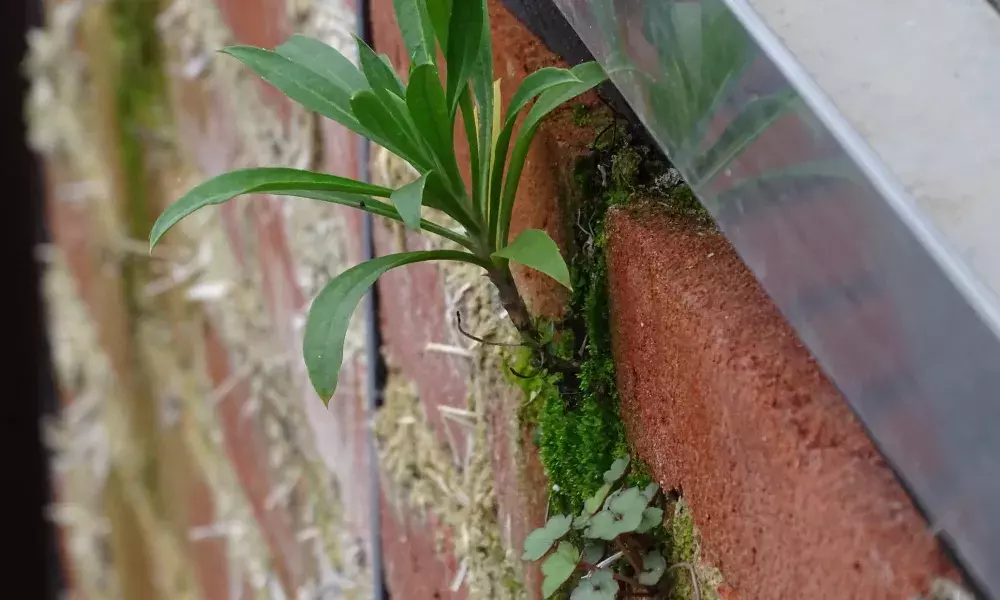

When talking to Koen recently, I learned that brick facades that are so typical for the Netherlands have lost their original function over the last decades. They are no longer an element of the structural construction of houses or quay walls but have been turned into aesthetic elements only. The structural construction – mostly made of steel and concrete – is behind the nice facade, which has no longer its original stabilising function. Does that mean that brick walls as structural elements are outdated and useless?
Not so for Koen. He actually finds brickwork and in particular the joints between the bricks highly interesting. He has been keen to explore, if the joints can be given a new function, when the chance to test it out came with the Urban Innovative Action initiative (UIA) and its GreenQuays project. Asked if he could join the project and provide his knowledge, he got very excited about the opportunity to bring research results to real life. The question was, if GreenQuays wants to go for green and nature-inclusive quay walls, what kind of construction needs to be underneath – what kind of bricks, mortar, and construction patterns?
Different options have been tried out in a mock-up at the University’s laboratory. The next step has been to build a small-scale test site in the canal with different wall segments to monitor the different designs and materials under real conditions. These results have been used by the designers of the Real-Life pilot area – a stretch of 175 meters in the city centre – on which materials and patterns to use. Construction will start later in 2021.
The time to decide on the layout of the small-scale test had been short – just a couple of months until the panels (brickwall segments) had to be erected in spring 2020. Hence, Koen and colleagues had to draw together information from their own research so far and brickwork experience in other cities such as Amsterdam and Rotterdam. They also had to stretch themselves and make some guesses on what could work well – not quite a researcher’s typical approach. At the end, the team selected 3 panels using bricks and different structural mortars and 2 panels with bricks, structural mortar plus a pointing mortar in the outer 2 cm of the joints. While the structural mortar would further stabilise the walls, the pointing mortar could be weaker and optimised to enable plant growth.


Finding the right mixing of these mortars has nevertheless been a challenge. It should still stick to the bricks. Inspiration was taken from the past when, e.g., limewater was used. While experimenting with the different materials, new ideas on material that could work well for plant life surfaced and Koen went for a wild card or “fantasy mortar” how he calls it. This mortar is very unusual. With his background knowledge and a portion of intuition, he had chosen clay, straw, and lime as the ingredients. There aren’t many research results to find on the features and long-term behaviour of such mixtures. For sure, the clay will contract under dry conditions and expand in wet weather and the straw is an organic material, which both create porosity that will nurture plant growth. Would the mixture still stick sufficiently? As the lockdown suddenly restricted the access to the University’s laboratory, Koen started experimenting with different mixtures in his garden to find the right combination that would work.

When I visited the small-scale pilot in September 2020, I could observe plant growth on the different wall segments. It seemed to work – on some panels better than on others. I even had the impression that on one panel, the plants have been thriving particularly well. And indeed, Koen confirmed to me that this was the panel with the phantasy mortar that only had come up while working with the layout of the small-scale test site and by the exchange with colleagues. It has been a “lucky guess”.
Despite excitement about the plant growth in this particular pointing mortar, it has not made it yet into the design of the Real-Life pilot. The mortar has been too new, too little tested yet and the risk was perceived too big for Breda municipality that wants to build something lasting. In addition, the small-scale test site shows that the mortar pollutes the wall over time, which is in conflict with the aesthetic appearance aimed for. However, panel 4 with the alternative, more conventional pointing mortar was the compromise to be applied.
Anyway, even if it has been too early for using the most innovative mortar for the constructions in GreenQuays, at the small-scale test site, it will further deliver data on the longer-term qualities. There are other sections of the river that will be reopened in the years to come and other projects concerning walls; and maybe, the material is sufficiently tested and improved until then? Koen is on the go and is already experimenting with further innovative wall constructions like dry-stack techniques. It is exciting to see that the UIA enables such experiments which otherwise would run behind laboratories’ doors instead of coming to life.
With the next article, I will take a closer look on how the expectations of plant life have been met on the small scale test site.
Find more information on: https://www.greenquays.nl
About this resource
The Urban Innovative Actions (UIA) is a European Union initiative that provided funding to urban areas across Europe to test new and unproven solutions to urban challenges. The initiative had a total ERDF budget of €372 million for 2014-2020.
Similar content




